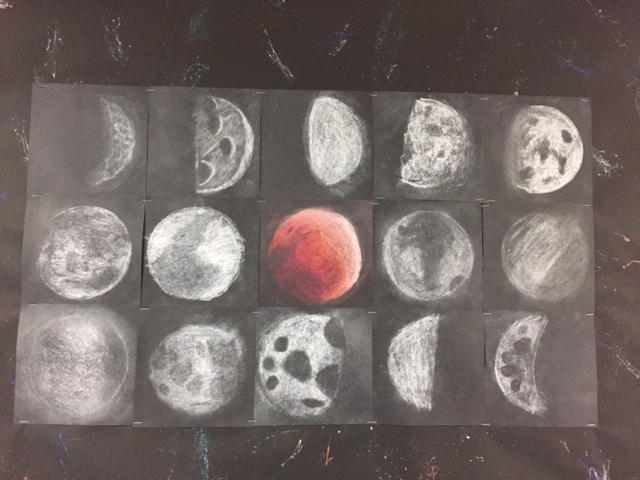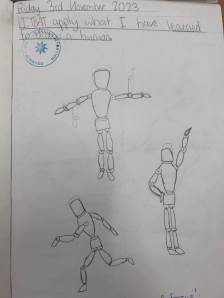Art
At John Stainer Primary School we place great emphasis on art, craft and design.
Art

Our weekly art lessons follow a progression of skills which focus on drawing, colour and form each term.

The development of these skills culminates in a termly “whole school art project”, which is often linked to a local gallery and/or the National Gallery. Children’s art is also linked across the curriculum, and demonstrates strong ties with other aspects of learning within the classroom. This is best displayed during our class exhibitions which take place each term and we see everything from erupting volcanoes to our very own versions of Christopher Wren’s architectural wonders!

We aim to promote children’s enjoyment of art by giving them skills and knowledge to enable them to appreciate and critique their own and other's work. Children are also encouraged to explore how famous artists used the skills they themselves are learning to create great masterpieces.
Through the teaching of art, children’s creativity is fostered and they are able to express themselves in a way that other curricular areas may not allow. It encourages focus and perseverance not to mention the further development of fine motor skills.
Perhaps nothing is more satisfying than to see the great pride a child possesses upon realising how much they have learned and in turn the masterpiece that they themselves have created.

Intent
At John Stainer, we deliver an imaginative, innovative and progressive Art curriculum which fosters enthusiasm and engagement. The intent of our Art curriculum is to:
- Provide exposure to a broad selection of artists, cultures, periods and movements.
- Encourage children to explore how famous artists used the skills the children themselvesare learning to create great masterpieces.
- Promote children’s skills and knowledge to enable them to appreciate and critique their own and other's work.
- Enable self-expression through individual interests, thoughts and ideas and in turn develop a social, moral, spiritual and cultural identity.
- Inspire children to explore famous local, national and international artists to enhance their awareness and knowledge.
- Introduce children to different movements in art and time to allow them to gain a historical perspective and make links with contemporary art.
- Understand the way that art contributes to a national identity and culture.
- Embrace how art impacts their lives and how they can represent themselves through artistic means.
Implementation
Our weekly art lessons follow a progression of skills which focus on drawing, colour and form each term. This progression of skills is regularly assessed and developed to ensure progression throughout the school.
Areas taught include:
- Mixed media
- Painting
- Drawing
- Sculpture
The development of skills culminates in a termly “whole school art project”. This termly project allows children to exhibit the skills they have refined throughout their art lessons. Our whole school art projects are linked to current events, and area of study, or is linked to a local or the National Gallery. Whole school art allows children to reflect on their own successes and take pride in their work by showcasing their final project throughout the school.
Our Art curriculum is also linked in other areas across the curriculum, and demonstrates strong ties with other aspects of learning within the classroom. For example, children in Year 5 study the work of Ephrem Kouakou and Elisha Ongere during their Africa unit, and Year 6 explore environmental impact of art while looking at the work of Jason deCaires Taylor. Cross curricular links are perhaps also displayed during our class exhibitions which take place each term and we see everything from erupting volcanoes to Tudor portraits to ancient Benin Bronzes.
Impact
Throughout the school, art, craft and design is documented through sketchbooks. In the EYFS, the children begin by mark making and using art with their story maps. As they progress to KS1/KS2, children use sketchbooks which move up with them throughout their years at John Stainer.
Teachers use observations, questioning and evidence in their books as an indication as to how much progress the children are making. This information is further used to support future planning and the development of the art scheme.
Each step of the children's journey through an art project is celebrated as can be seen by the progression of knowledge and skills displayed around the school, as well as in children's sketch books. Children are encouraged not to look at their final piece of work- but rather to look at where the process began, and where it ended.
Overall, through the teaching of art, children’s creativity is fostered and they are able to express themselves in a way that other curricular areas may not allow. It encourages focus and perseverance and the further development of fine motor skills.
Perhaps nothing is more satisfying than to see the great pride a child possesses upon realising how much they have learned and in turn, the masterpiece that they themselves have created.
Beyond the curriculum
1) Working with The National Gallery - Take One Picture
All year groups are currently participating in the annual Take One Picture programme put on by the National Gallery. This year, the children are studying Claude Joseph Vernet’s “A Shipwreck on Stormy Seas”. The children have all explored the painting and together decided on an area of focus which they will interpret, make links with and create a piece of art based on Vernet's art. We can’t wait to see their creativity unfold.
2) Art club

Art club is one of our many extracurricular clubs. Like other clubs, our Art club is designed to consolidate the learning that takes place in lessons, introduce new skills and techniques and challenge and excite students.
3) Talk About Art
This year we have had the pleasure of working with “Talk About Art” who ran a 9-week art course with some of our budding KS2 artists. Each after school session allowed children to be introduced to a current artist with an innovative approach to environmentally friendly works of art. These pioneering creatives became the inspiration for our own work, which children collaboratively designed, resourced and created.
Click the image below to see the children's amazing work in the blog.
4) Steve McQueen's epic Year 3 project
It is believed that Year 3 is a milestone year in a child's development and sense of identity. This artwork project can be seen on over 600 billboards across all 33 of London's boroughs. The billboards feature huge class photos of year 3 school children from London primary schools. A collection of these photos can be viewed in our main Reception area and continues to be a huge talking point for our children, staff and visitors to our school. The project has further raised our children's awareness and appreciation for the work of another artist.






